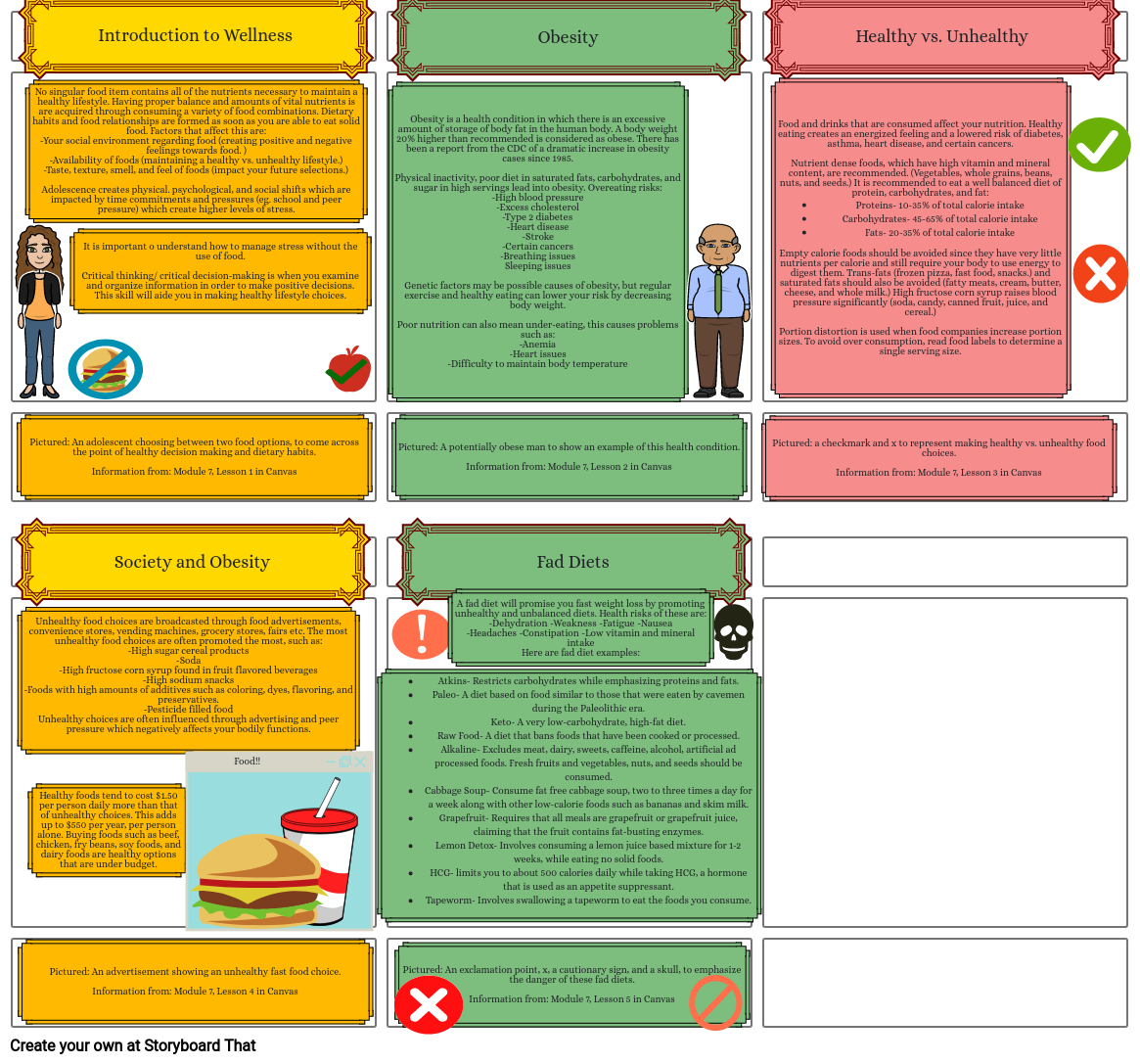Nutrition

Storyboard Text
- Introduction to Wellness
- No singular food item contains all of the nutrients necessary to maintain a healthy lifestyle. Having proper balance and amounts of vital nutrients is are acquired through consuming a variety of food combinations. Dietary habits and food relationships are formed as soon as you are able to eat solid food. Factors that affect this are:-Your social environment regarding food (creating positive and negative feelings towards food. )-Availability of foods (maintaining a healthy vs. unhealthy lifestyle.)-Taste, texture, smell, and feel of foods (impact your future selections.)Adolescence creates physical. psychological, and social shifts which are impacted by time commitments and pressures (eg. school and peer pressure) which create higher levels of stress.
- It is important o understand how to manage stress without the use of food.Critical thinking/ critical decision-making is when you examine and organize information in order to make positive decisions. This skill will aide you in making healthy lifestyle choices.
- Obesity is a health condition in which there is an excessive amount of storage of body fat in the human body. A body weight 20% higher than recommended is considered as obese. There has been a report from the CDC of a dramatic increase in obesity cases since 1985. Physical inactivity, poor diet in saturated fats, carbohydrates, and sugar in high servings lead into obesity. Overeating risks:-High blood pressure-Excess cholesterol-Type 2 diabetes-Heart disease-Stroke-Certain cancers-Breathing issuesSleeping issuesGenetic factors may be possible causes of obesity, but regular exercise and healthy eating can lower your risk by decreasing body weight. Poor nutrition can also mean under-eating, this causes problems such as:-Anemia-Heart issues-Difficulty to maintain body temperature
- Obesity
- Healthy vs. Unhealthy
- Food and drinks that are consumed affect your nutrition. Healthy eating creates an energized feeling and a lowered risk of diabetes, asthma, heart disease, and certain cancers.Nutrient dense foods, which have high vitamin and mineral content, are recommended. (Vegetables, whole grains, beans, nuts, and seeds.) It is recommended to eat a well balanced diet of protein, carbohydrates, and fat:Proteins- 10-35% of total calorie intakeCarbohydrates- 45-65% of total calorie intakeFats- 20-35% of total calorie intakeEmpty calorie foods should be avoided since they have very little nutrients per calorie and still require your body to use energy to digest them. Trans-fats (frozen pizza, fast food, snacks.) and saturated fats should also be avoided (fatty meats, cream, butter, cheese, and whole milk.) High fructose corn syrup raises blood pressure significantly (soda, candy, canned fruit, juice, and cereal.)Portion distortion is used when food companies increase portion sizes. To avoid over consumption, read food labels to determine a single serving size.
- Society and Obesity
- Pictured: An adolescent choosing between two food options, to come across the point of healthy decision making and dietary habits. Information from: Module 7, Lesson 1 in Canvas
- Unhealthy food choices are broadcasted through food advertisements, convenience stores, vending machines, grocery stores, fairs etc. The most unhealthy food choices are often promoted the most, such as:-High sugar cereal products-Soda-High fructose corn syrup found in fruit flavored beverages-High sodium snacks-Foods with high amounts of additives such as coloring, dyes, flavoring, and preservatives.-Pesticide filled foodUnhealthy choices are often influenced through advertising and peer pressure which negatively affects your bodily functions.
- Atkins- Restricts carbohydrates while emphasizing proteins and fats.Paleo- A diet based on food similar to those that were eaten by cavemen during the Paleolithic era.Keto- A very low-carbohydrate, high-fat diet.Raw Food- A diet that bans foods that have been cooked or processed.Alkaline- Excludes meat, dairy, sweets, caffeine, alcohol, artificial ad processed foods. Fresh fruits and vegetables, nuts, and seeds should be consumed.Cabbage Soup- Consume fat free cabbage soup, two to three times a day for a week along with other low-calorie foods such as bananas and skim milk. Grapefruit- Requires that all meals are grapefruit or grapefruit juice, claiming that the fruit contains fat-busting enzymes. Lemon Detox- Involves consuming a lemon juice based mixture for 1-2 weeks, while eating no solid foods. HCG- limits you to about 500 calories daily while taking HCG, a hormone that is used as an appetite suppressant.Tapeworm- Involves swallowing a tapeworm to eat the foods you consume.
- Pictured: A potentially obese man to show an example of this health condition. Information from: Module 7, Lesson 2 in Canvas
- Fad Diets
- A fad diet will promise you fast weight loss by promoting unhealthy and unbalanced diets. Health risks of these are:-Dehydration -Weakness -Fatigue -Nausea-Headaches -Constipation -Low vitamin and mineral intake Here are fad diet examples:
- Pictured: a checkmark and x to represent making healthy vs. unhealthy food choices. Information from: Module 7, Lesson 3 in Canvas
- Pictured: An advertisement showing an unhealthy fast food choice. Information from: Module 7, Lesson 4 in Canvas
- Healthy foods tend to cost $1.50 per person daily more than that of unhealthy choices. This adds up to $550 per year, per person alone. Buying foods such as beef, chicken, fry beans, soy foods, and dairy foods are healthy options that are under budget.
- Food!!
- Pictured: An exclamation point, x, a cautionary sign, and a skull, to emphasize the danger of these fad diets.Information from: Module 7, Lesson 5 in Canvas
Over 30 Million Storyboards Created

